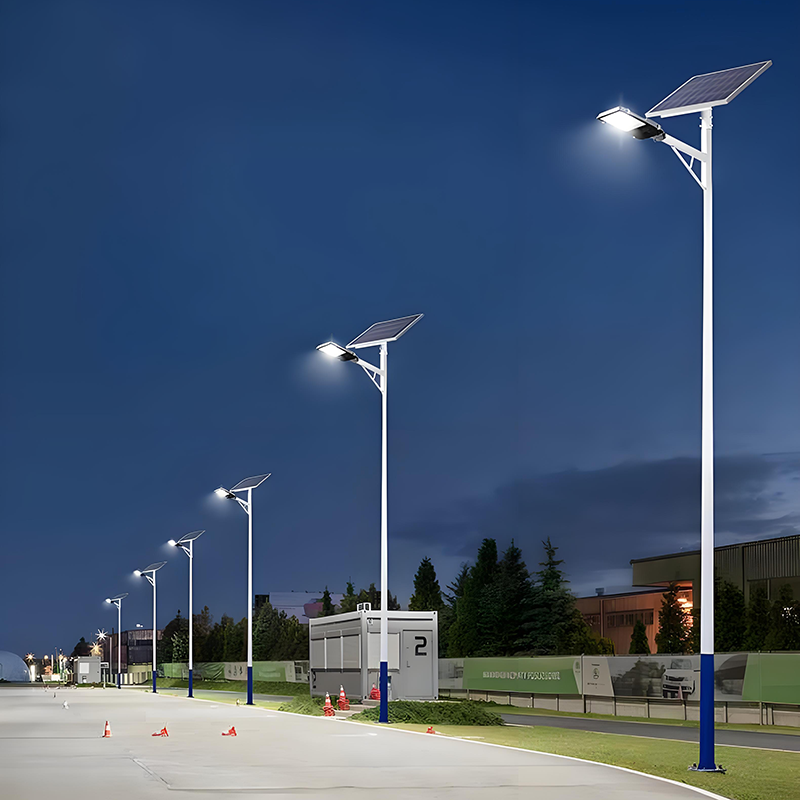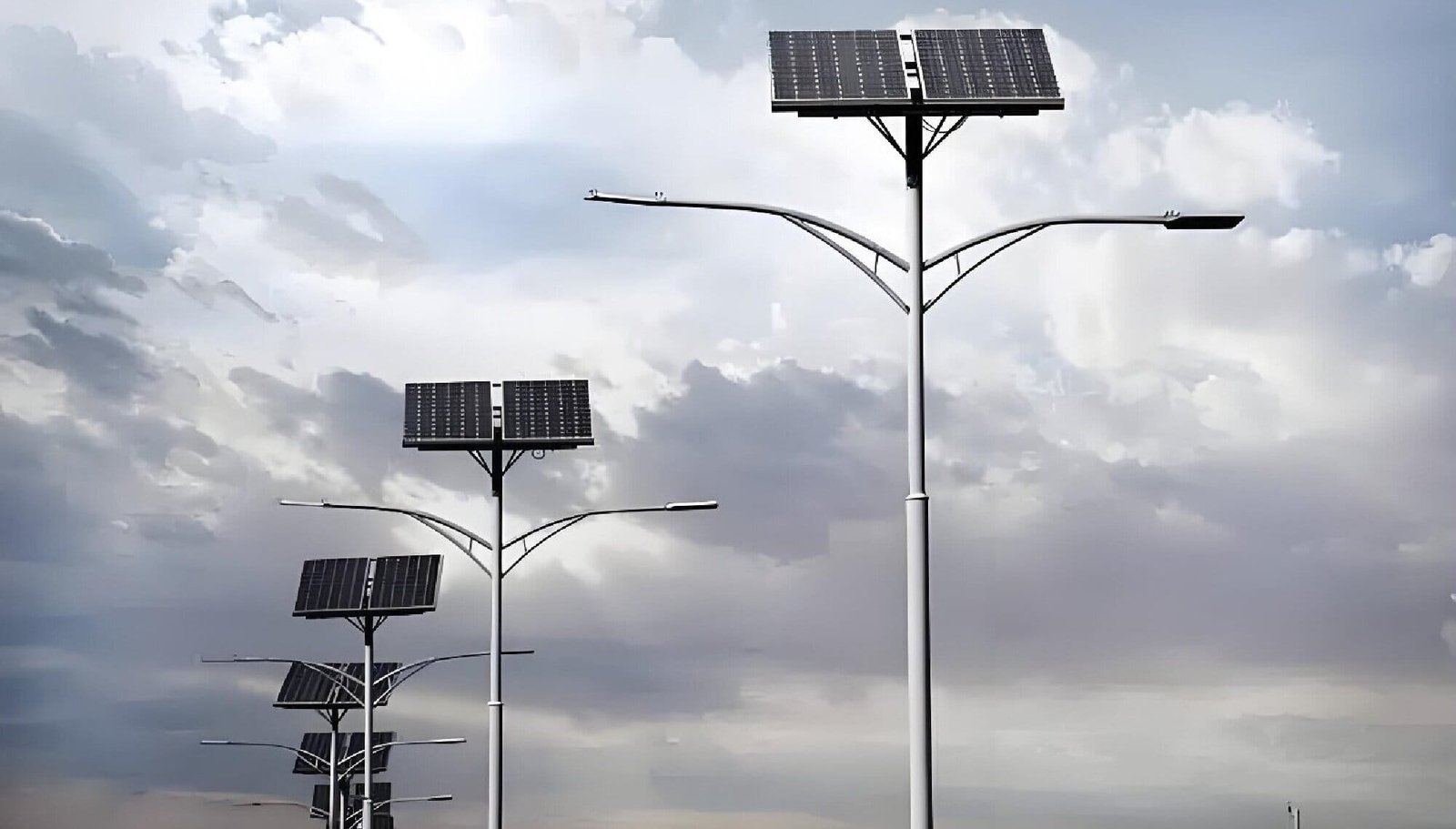Solar street lights are a sustainable and efficient alternative to traditional street lighting systems, harnessing solar energy to power LED lights through a fully integrated, autonomous system. They work by converting sunlight into electricity using photovoltaic panels, storing it in batteries, and powering street lights during the night.
Here's a breakdown of how they function, their components, and the technology behind them.
What Are the Disadvantages of Solar Street Lights?
Solar street lights are known for their environmental benefits, but like any technology, they come with certain drawbacks. The primary disadvantages of solar street lights include their initial investment cost, weather sensitivity, and the eventual need for battery replacements. Let’s take a closer look at these factors:
-
Initial Investment: One of the biggest hurdles for solar street lighting is the higher upfront cost compared to conventional lighting systems. The price of solar panels, batteries, LED fixtures, and installation can be substantial, making it a significant investment for cities or municipalities.
-
Weather Sensitivity: Solar performance can be negatively impacted by long periods of cloudy weather, snow, or dust accumulation on the panels. In areas with inconsistent sunlight, the efficiency of solar street lights can decrease, affecting their reliability and performance.
-
Battery Lifespan: Solar street lights rely on rechargeable batteries to store energy for nighttime use. These batteries have a limited lifespan and will eventually need replacing, adding to the long-term maintenance costs.
Despite these challenges, the benefits of solar street lights—such as energy savings, eco-friendliness, and low maintenance—often outweigh the disadvantages, particularly when the long-term cost savings are considered.
Dive Deeper into Disadvantages
When looking at the disadvantages of solar street lights, it's essential to understand how each of these factors affects the overall performance and feasibility of the system.
High Initial Investment
The initial cost of solar street lights can be several times higher than traditional lighting. This is due to the price of photovoltaic (solar) panels, storage batteries, and LED lamps. The cost of installation is also higher, as solar street lights often require specialized poles and electrical systems to house and connect the various components.
However, these higher upfront costs can be recouped over time through reduced energy consumption. Solar street lights don't need to be connected to the local power grid, which means ongoing electricity bills are minimized or even eliminated entirely. In addition, maintenance costs tend to be lower over time, as there are no bulbs to replace frequently and minimal wear and tear on the system.
Weather Sensitivity and Location Challenges
In regions with extended periods of poor weather, such as heavy rains, snow, or extended cloud cover, solar street lights may not be able to capture enough sunlight to charge their batteries fully. This can result in dim lighting or even the complete failure of the system.
Maintenance of the solar panels is also crucial in areas where dust or debris is a concern. Dirty panels can block sunlight and reduce the efficiency of the system. Therefore, solar street lights may need regular cleaning, especially in arid or industrial areas where pollution is high.
Battery Lifespan and Replacement
The batteries used in solar street lights are typically deep-cycle lead-acid or gel cell batteries. These batteries can last anywhere from 3 to 5 years, depending on the quality and usage. Over time, the batteries will degrade, leading to reduced capacity and the need for replacement.
Battery replacement can be expensive, and it’s an ongoing maintenance cost that must be factored into the overall cost of ownership of solar street lights. Furthermore, improper disposal of batteries can lead to environmental concerns, as these batteries contain hazardous materials.
How Long Do Solar Street Lights Last?
The longevity of solar street lights depends on various factors, such as the quality of components, environmental conditions, and how well the system is maintained. Generally, solar street lights can last anywhere from 5 to 15 years. Here's an overview of the key components that contribute to their lifespan:
-
Solar Panels: Typically last 20 to 25 years or more, with only a gradual decrease in efficiency over time. After this period, they may need to be replaced or upgraded to ensure optimal performance.
-
LED Lights: These can last up to 50,000 hours, meaning they will outlast most other components in the system. However, LED light performance can degrade slightly over time.
-
Batteries: The most vulnerable component in a solar street light, with a lifespan of about 3 to 5 years, depending on the quality and usage.
By regularly maintaining the system and replacing worn-out parts, you can ensure that your solar street light system operates efficiently for a long time.
Dive Deeper into Lifespan
The lifespan of solar street lights depends largely on the materials and technology used. While the system itself can last for many years, the individual components may need replacing or upgrading over time.
Solar Panels Longevity
Solar panels are generally the most durable part of the solar street lighting system. High-quality panels can last for 20 to 25 years with minimal maintenance. However, it's important to note that solar panels lose efficiency as they age. A panel that produces 100% of its rated capacity when new might only produce 80% to 90% of that capacity after 20 years.
Regular cleaning and monitoring can help extend the life of solar panels. As technology advances, newer, more efficient panels may be available, allowing for better energy capture and performance.
LED Lights and Efficiency
LED lights are one of the most efficient lighting technologies available, and they can last for many years. Most LEDs have a lifespan of 50,000 hours or more, which means they will last far longer than traditional street lights. However, their brightness may decrease over time as the diodes wear out.
LED lights also tend to lose their brightness gradually rather than burning out suddenly, which is a significant advantage. Regularly replacing LEDs ensures that the light output remains consistent, providing bright, reliable illumination for years.
Battery Replacement and Maintenance
While solar panels and LED lights have impressive lifespans, the batteries used in solar street lights are the most time-sensitive component. As batteries degrade over time, they lose their ability to store and provide energy efficiently. Depending on usage, these batteries may need to be replaced every 3 to 5 years.
Routine battery maintenance, such as checking charge levels and replacing worn-out batteries, can help extend the life of the entire system. Many solar street light manufacturers provide detailed guidance on when to replace batteries, ensuring that the lights continue to function reliably.
Can LED Lights Last All Night?
Yes,LED lights can last all night, but this depends on several factors, such as the capacity of the solar panel, battery storage, and the power consumption of the LED light itself. In an ideal setup, where the solar panel is sufficiently large and the battery has enough capacity to store energy during the day, LED lights can easily stay on throughout the night.
LEDs are highly efficient, meaning they use very little power while providing bright, consistent illumination. The energy stored in the batteries is enough to keep the lights running for extended periods, even in areas where sunlight is limited.
However, if the solar panel doesn't receive enough sunlight during the day due to weather conditions or poor placement, the battery may not be fully charged, resulting in the lights turning off earlier than expected.
Dive Deeper into LED Lifespan
LED lights are designed to be energy-efficient and have long lifespans. However, for them to last throughout the night, proper design and integration with the solar system are essential.
Power Consumption and Battery Capacity
LED lights are low-power devices, meaning they don’t consume much energy compared to traditional street lights. This allows solar street lighting systems to run efficiently on stored energy. However, the ability of the system to last through the entire night depends on the battery’s capacity and how much energy the LED consumes.
A high-capacity battery, combined with an efficient LED lights, can ensure the lights remain on all night, even in challenging weather conditions. In contrast, a smaller battery or inefficient LED might not provide enough power to keep the light on for the desired period.
Battery Sizing for Optimal Performance
One of the key considerations when installing solar street lights is selecting the correct battery size. A larger battery allows the light to stay on for longer periods, even during cloudy or rainy days when solar charging is reduced. On the other hand, an undersized battery might result in the lights turning off before dawn.
Careful planning and integration of the solar panel, battery, and LED fixture ensure that the system provides continuous lighting throughout the night, meeting the needs of the area it serves.
Conclusion
Solar street lights are an innovative, sustainable solution to urban and rural lighting needs. Their ability to harness solar energy and provide reliable illumination throughout the night makes them a popular choice for many municipalities. By understanding their components, lifespan, and the challenges they face, you can make informed decisions about their use and maintenance, ensuring that they remain effective for many years to come.





